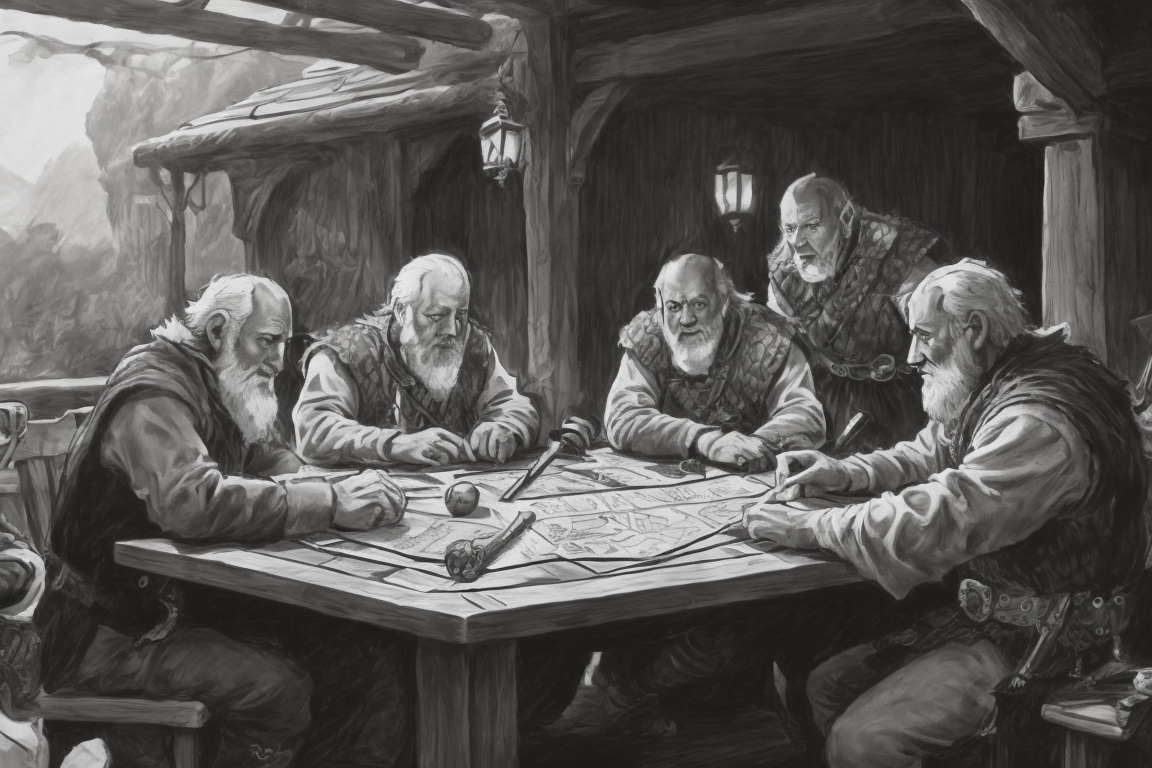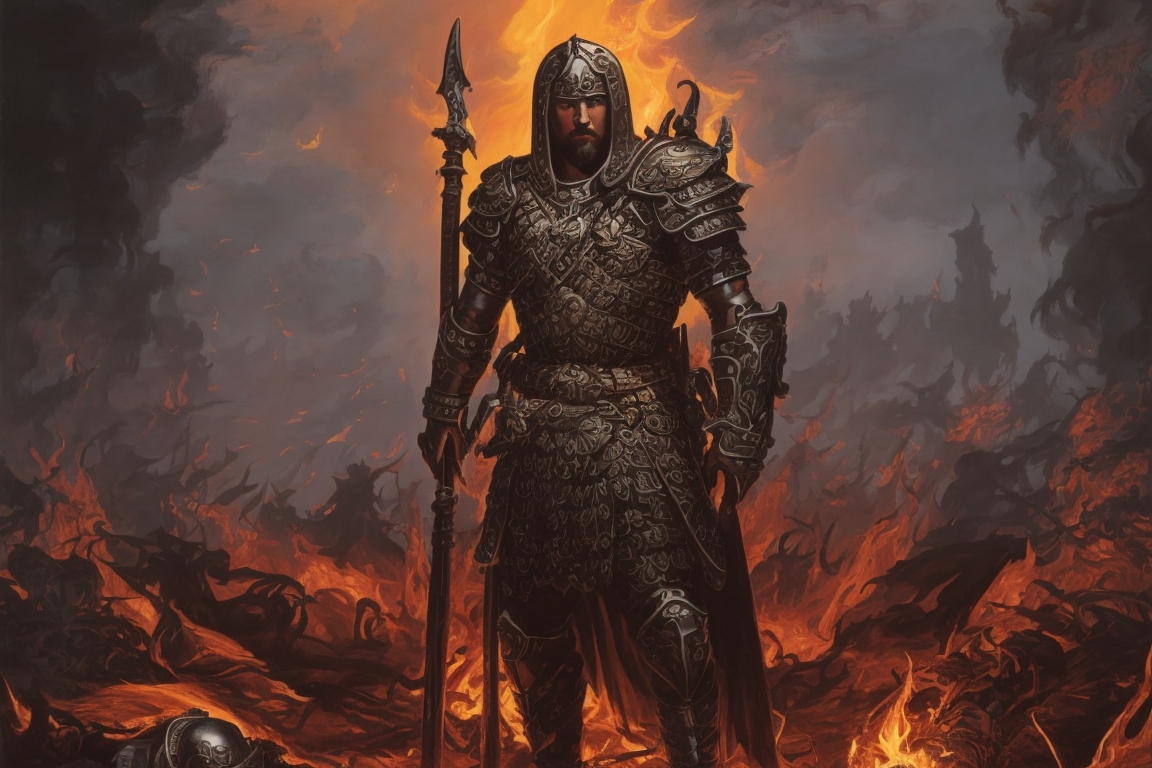The integration of classic Dungeons & Dragons modules B1 (“In Search of the Unknown”) and B2 (“The Keep on the Borderlands”) with the Outdoor Survival map offers a unique and expansive setting for both novice and experienced players. This approach blends the structured dungeon-crawling experience of B1 and B2 with the open-world exploration offered by the Outdoor Survival map.
B1 and B2 are seminal D&D modules that have served as introductory adventures for countless players. B1 focuses on a well-crafted but empty dungeon, leaving the game master the task of populating it. B2 presents a keep and surrounding wilderness filled with various challenges. The Outdoor Survival map, originally a board game, provides a vast wilderness setting ideal for hex-crawling adventures.

Initial Setup
- Placement of B2’s Keep:
- Central Hub: Position the keep at the heart of the Outdoor Survival map (settlement number 4, making it the primary base for players. This central location provides a strategic point from which players can venture into the wilderness.
- Map Integration: Overlay the B2 module map onto the central hex (or settlement number 4 due to terrain) of the Outdoor Survival map. Ensure geographical consistency, aligning terrain features for a seamless transition.
- Incorporation of B1:
- Dungeon Placement: Designate a location within B2’s wilderness, such as the “Cave of the Unknown,” to house the B1 dungeon. This creates a narrative link and encourages players to explore. This can be done by finding the mountains pass south of settlement number for that leads to the catch basin. This location offers a bit of wilderness travel and a natural mountainous region to locate the caves in.
- Story Integration: Develop hooks and rumors that guide players from B2’s keep to B1’s dungeon, creating a cohesive storyline.

Early Levels (1-3)
- Familiarization:
- Initial Exploration: Encourage players to explore the immediate surroundings of the keep, focusing on the 5-mile hex area. Populate this area with minor encounters and quests to build familiarity with the setting.
- Character Development: Use these early adventures to introduce key NPCs and establish the local lore, helping players immerse themselves in the game world.
- Structured Challenges:
- Balanced Encounters: Design encounters to match the players’ early skill levels, providing a mix of combat, puzzles, and role-playing opportunities.
- Resource Management: Introduce basic survival elements, such as managing supplies and navigating terrain, to prepare players for more complex challenges ahead.

Mid Levels (4-6)
- Expanding Horizons:
- Wilderness Exploration: Gradually expand the exploration radius, incorporating more of the Outdoor Survival map. Introducing further travel opens new regions, each with distinct environments and challenges that will be unlocked via gameplay.
- Faction Dynamics: Use the First Edition Advanced Dungeons & Dragons Dungeon Masters Guide to populate the wilderness with various factions, such as rival adventurers, merchant caravans, and local tribes. These factions add depth to the world and provide dynamic interactions. They will be generated by the players as encounters are rolled and the world evolves.
- Advanced Quests:
- Complex Missions: Design multi-part quests that require players to travel across different hexes, solving problems and uncovering secrets. These quests should tie into the larger narrative that has been arising via natural campaign play and offer significant rewards.
- Strategic Elements: Introduce strategic elements, such as defending the keep or establishing alliances with unlocked factions. These elements encourage long-term planning and group coordination.
Advanced Levels (7+)
- Hex-Crawl Transition:
- Full Map Exploration: Transition to a full hex-crawl experience, where players are encouraged to explore the entire Outdoor Survival map. Emphasize the scale and diversity of the wilderness.
- Geopolitical Storylines: Introduce larger geopolitical storylines, such as regional conflicts or ancient prophecies, that drive the overarching campaign narrative.
- Long-Term Goals:
- Epic Quests: Allow the Geopolitical discoveries to facilitate the growth of epic quests that span multiple regions and require extensive planning and resource management. These quests should challenge the players’ abilities and offer substantial payoff.
- World-Building: Continuously build upon the world’s lore, adding new locations, characters, and histories. Encourage players to shape the world through their actions and decisions.
The Dynamics of Integrating B1/B2 Modules with the Outdoor Survival Map
Expanding the Game World
The combination of the B1 (“In Search of the Unknown”) and B2 (“The Keep on the Borderlands”) modules with the Outdoor Survival map introduces a dynamic shift in gameplay from structured dungeon-crawling to expansive wilderness exploration. This fusion allows for a gradual progression that keeps players engaged and challenged at each stage of their journey.
Balancing Structure and Freedom
Early Game (Levels 1-3): The initial focus is on structured encounters and familiarization with the game mechanics and setting. The controlled environment of the keep and its immediate surroundings helps players gain confidence and establish their characters within the narrative. Early quests are designed to be straightforward, providing a balance of combat, puzzle-solving, and role-playing opportunities.
Mid Game (Levels 4-6): As players advance, the game’s scope widens to include more of the Outdoor Survival map. This phase introduces a blend of structured and open-ended gameplay. The introduction of factions and diverse wilderness regions keeps the experience fresh and engaging. Players are encouraged to explore and interact with the world more freely, which fosters a sense of adventure and discovery.
Late Game (Levels 7+): In the late game, the transition to a full hex-crawl experience becomes prominent. Players are given the freedom to explore the entire map, encounter geopolitical storylines, and engage in epic quests that require strategic planning and long-term thinking. The open-world nature of this phase allows for a high degree of player agency, making their actions and decisions have significant impacts on the game world.

Enhancing Player Engagement
- Narrative Depth: Integrating the modules with the map enriches the narrative by providing a vast, interconnected world. The continuity between the keep, the wilderness, and the dungeons creates a cohesive story that evolves with the players’ actions.
- Dynamic Interactions: The presence of various factions and dynamic elements within the wilderness adds layers of interaction. Players can form alliances, negotiate with rivals, and influence regional politics, making their choices meaningful and impactful.
- Exploration and Discovery: The hex-crawl aspect encourages players to explore unknown territories, uncover hidden secrets, and encounter unexpected challenges. This sense of exploration enhances the overall immersion and excitement of the game.
Challenges and Solutions
- Maintaining Balance: One of the main challenges is maintaining a balance between structured and open-ended gameplay. Game masters must carefully design encounters and quests that scale appropriately with the players’ levels and abilities.
- Consistent World-Building: Continuously expanding the game world through play while ensuring consistency and coherence via strict time records to lessen the demand placed upon the referees. Keep detailed notes and maps to track players’ progress and the evolving state of the world.
- Player Engagement: Keeping players engaged over long campaigns requires varied and interesting content. Game masters should utilize different types of quests, encounters, and challenges to maintain a dynamic and engaging experience.





